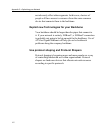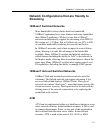
Appendix D • Glossary of Terms
outside the subnet and serves as connection between the current
subnet and the outside world.
DHCP – Refers to the Dynamic Host Configuration Protocol
used by a host to obtain all necessary configuration information
including IP addresses.
DLL – Dynamic Linked Library, a development tool.
DNS – ‘Domain Name System’, the online distributed database
system being used to map human-readable machine names into
IP addresses. DNS servers throughout the Internet implement a
hierarchical namespace allowing sites the freedom in assigning
machine names and addresses. DNS also supports separate
mappings between mail destinations and IP addresses.
Domain – In general, a domain is an area of control or a sphere
of knowledge. In computing and telecommunication in general,
a domain is a sphere of knowledge identified by a name.
Typically, the knowledge is a collection of facts about some
program entities or a number of network points or addresses.
On the Internet, a domain consists of a set of network addresses.
This domain is organized in levels. The top level identifies
geographic or purpose commonality (for example, the nation
that the domain covers or a category such as "commercial").
The second level identifies a unique place within the top level
domain and is, in fact, equivalent to a unique address on the
Internet (an IP address). Lower levels of domain may also be
used.
Strictly speaking, in the Internet's domain name system (DNS),
a domain is a name with which name server records are
associated that describe subdomains or host. For example,
"optibase.com" could be a domain with records for
"www.optibase.com" and "www1.optibase.com," and so forth.
In Windows NT and Windows 2000, a domain is a set of
network resources (applications, printers, and so forth) for a
group of users. The user only needs to log on to the domain to
gain access to the resources, which may be located on a number
of different servers in the network.
129


















